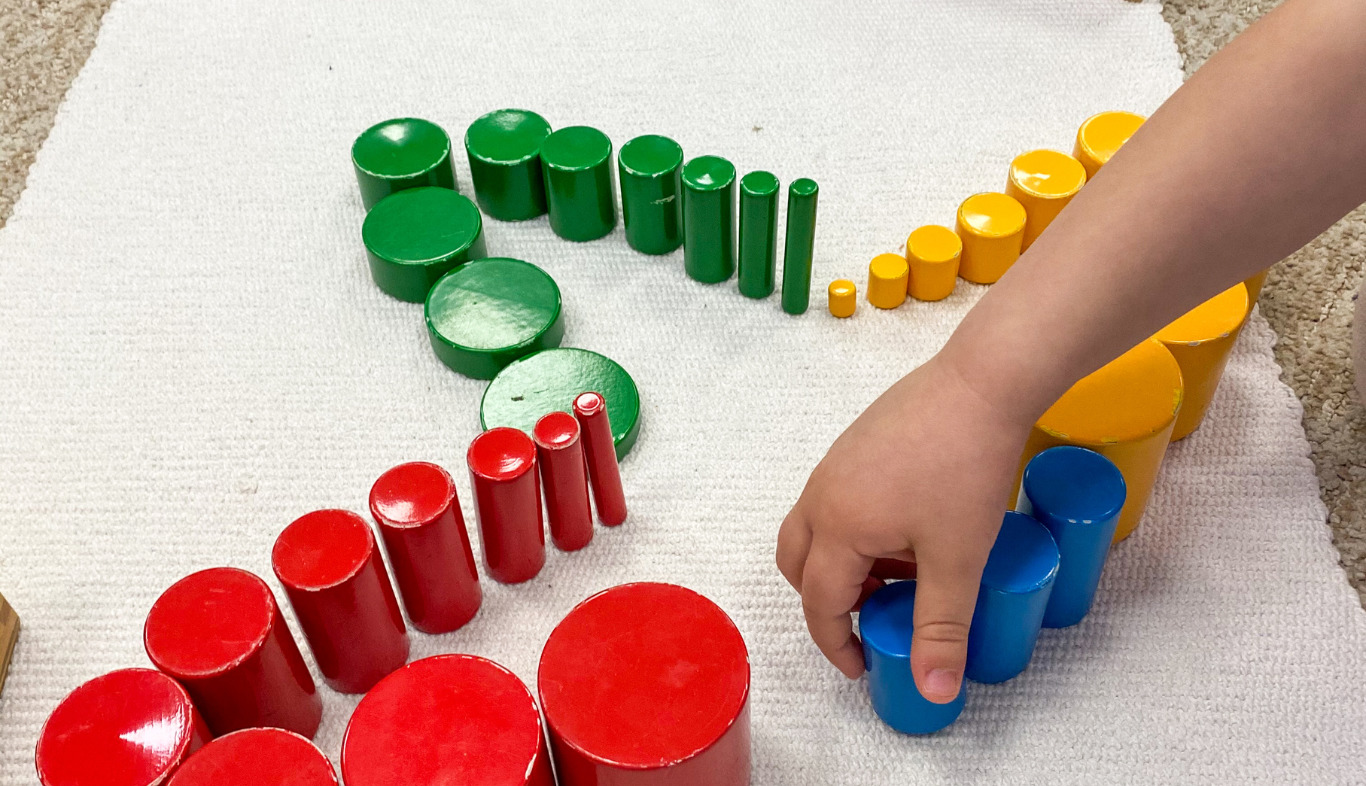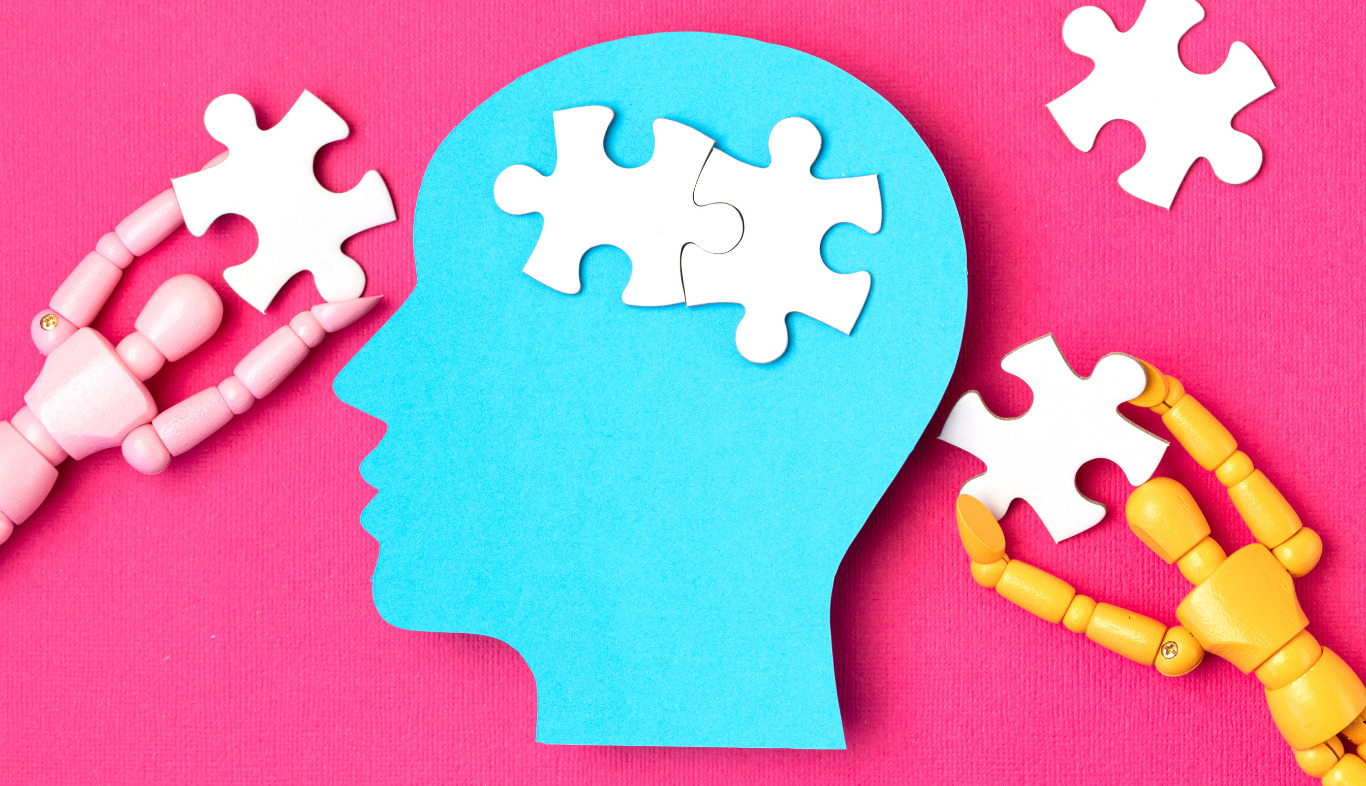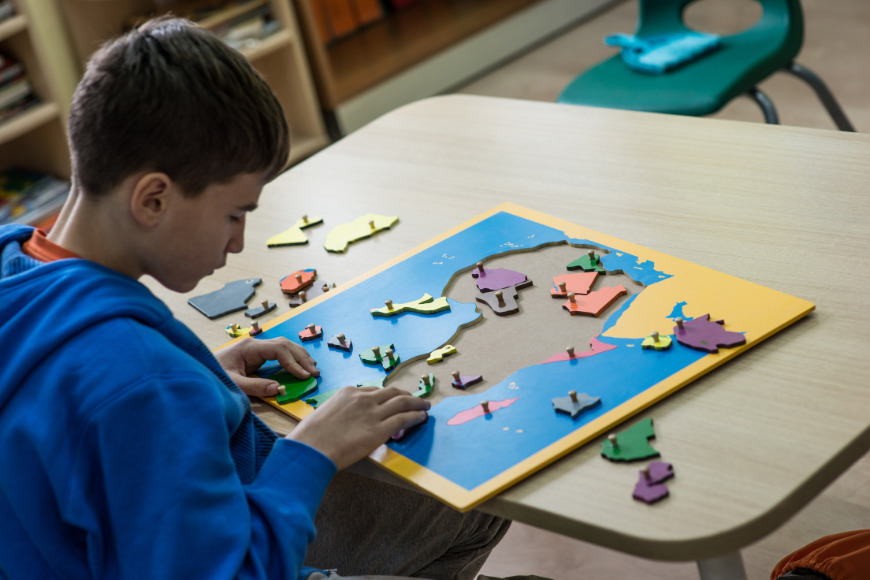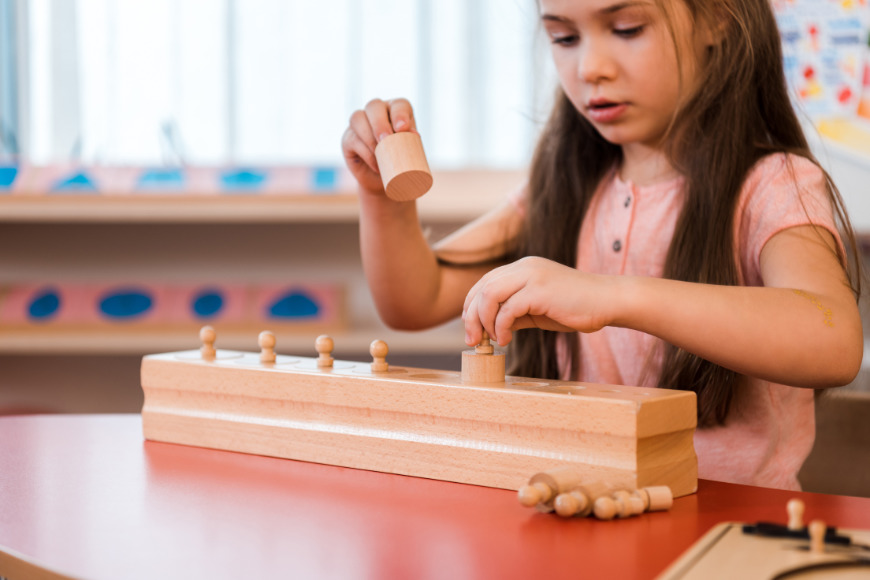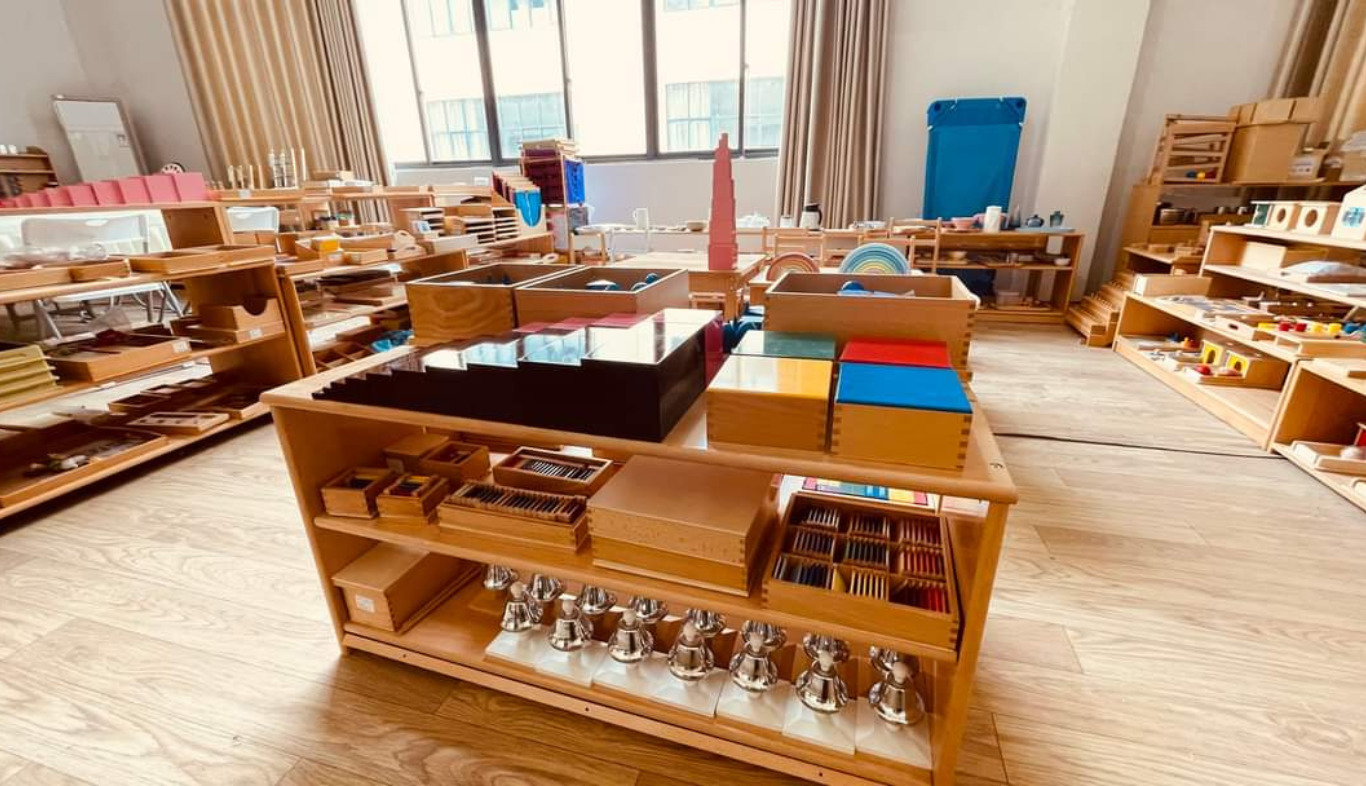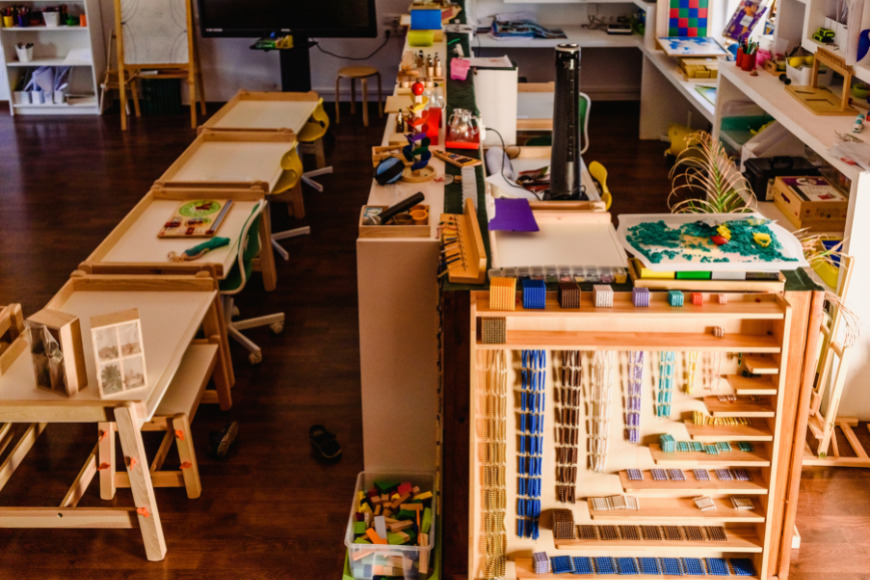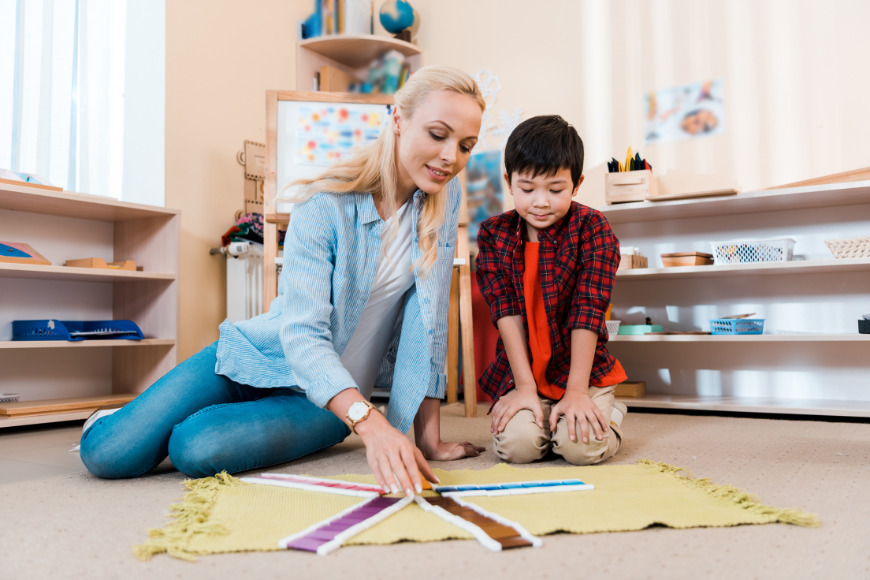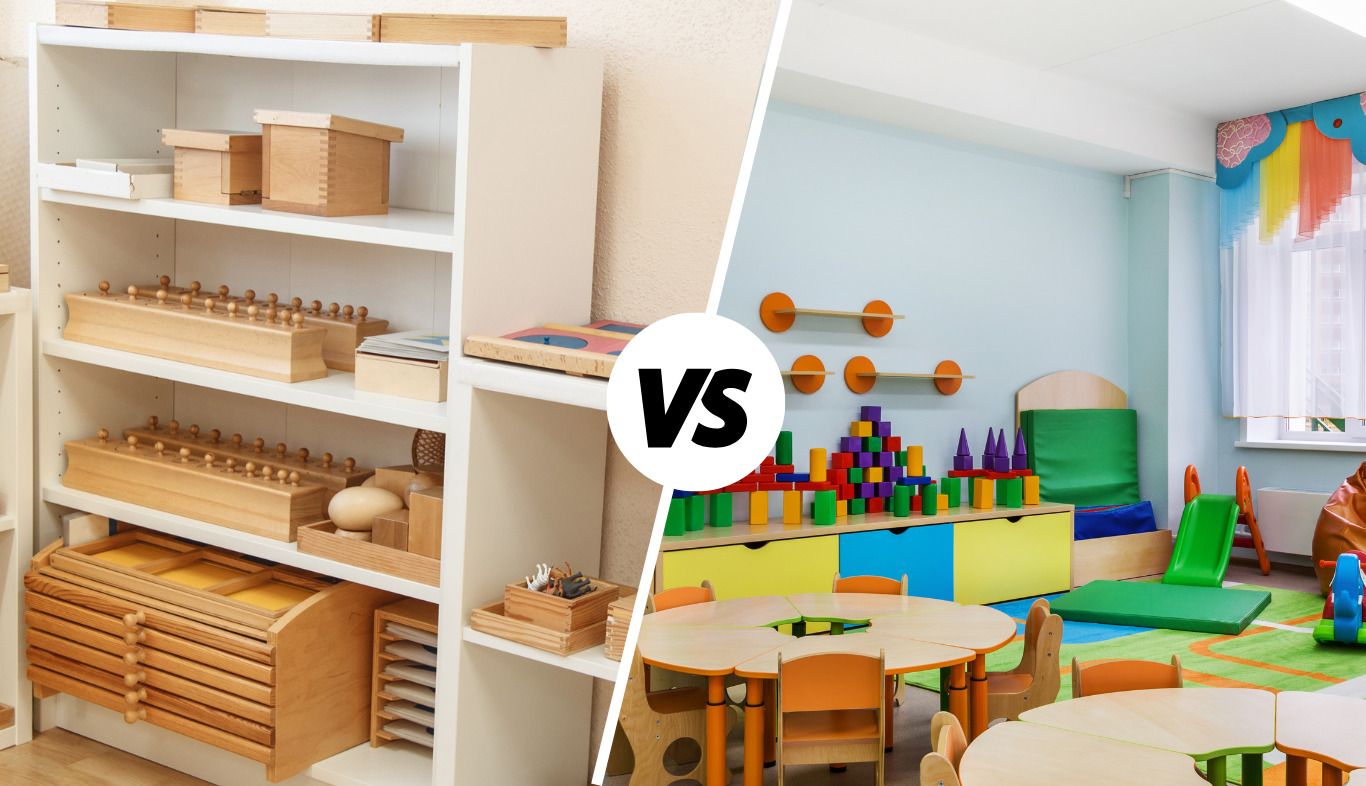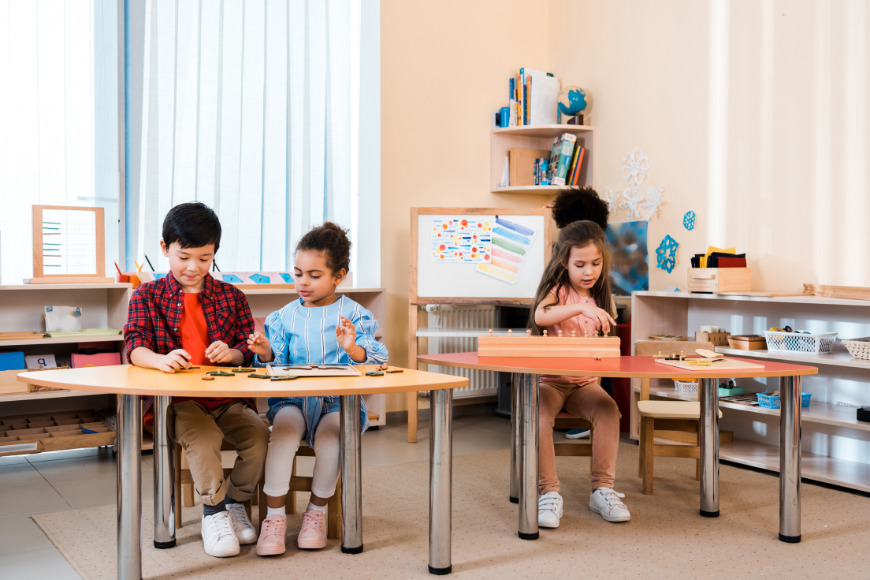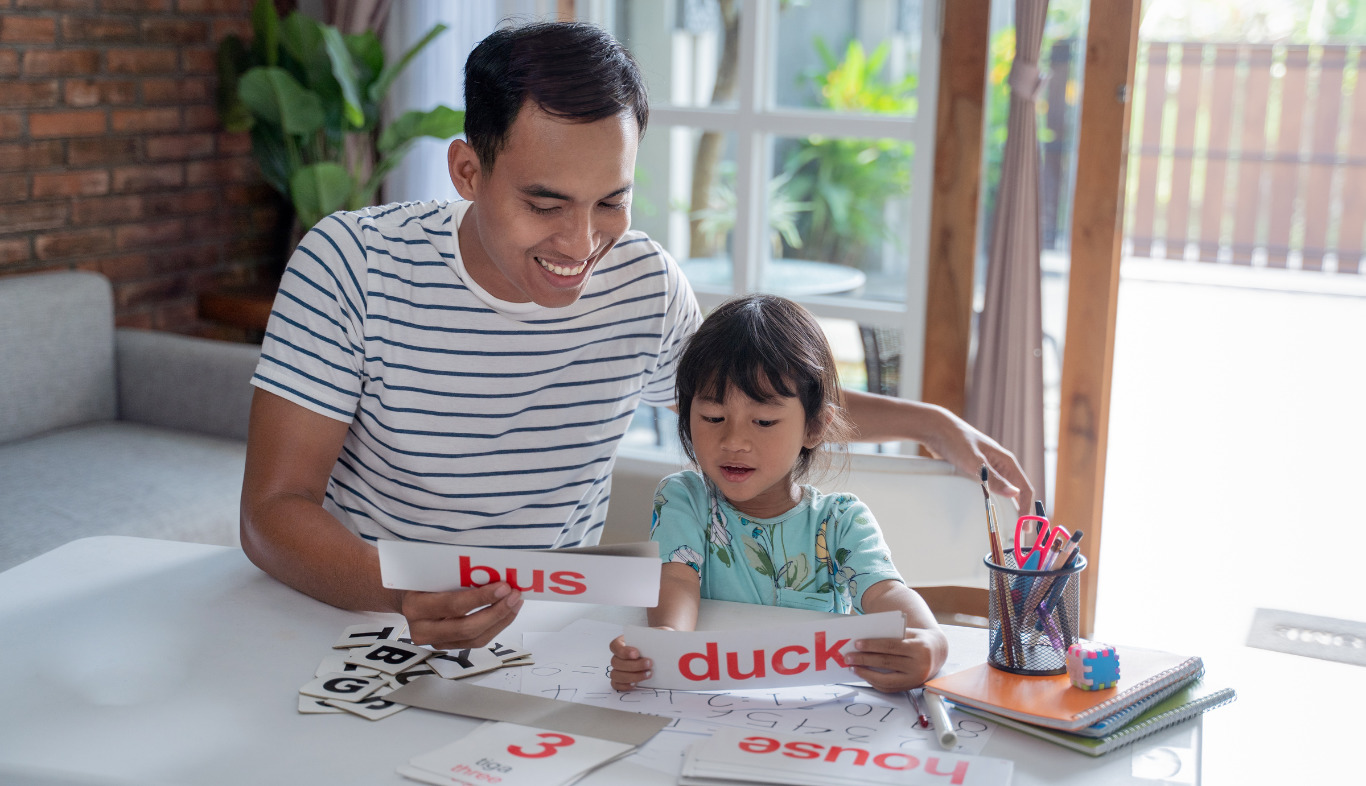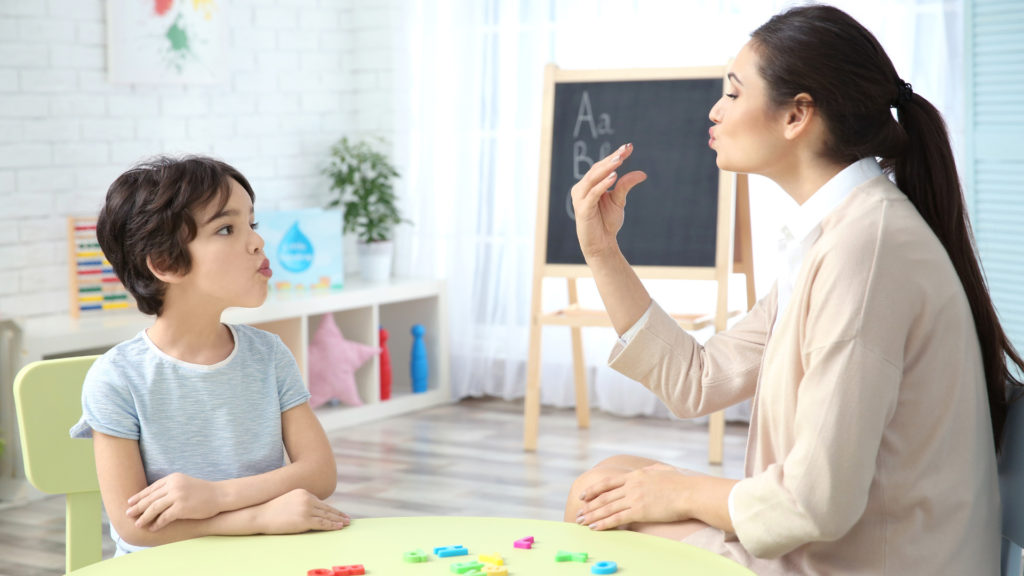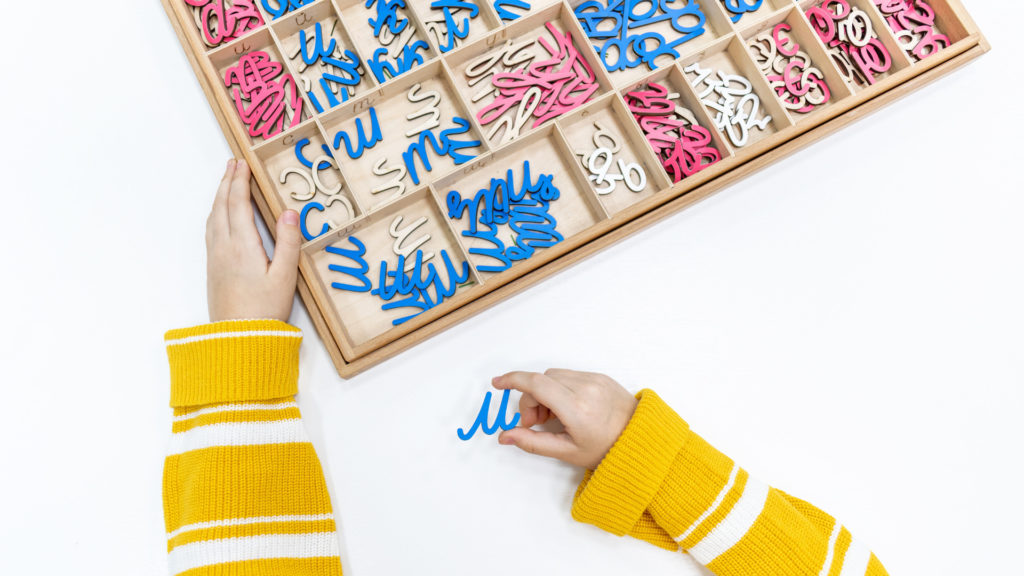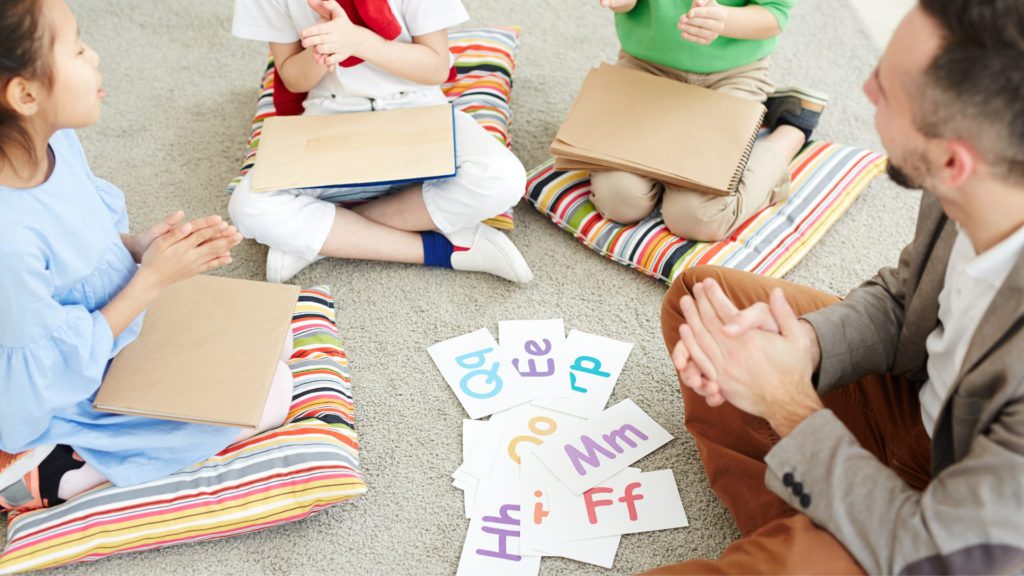Learning begins at birth when a child observes through their senses (e.g., sight, taste, smell, hearing, touch). This is the reason why newborns respond to sound and touch. Sensory learning is a natural way for children to learn about their environment and from real-life experiences to develop problem-solving skills.
“The senses, being explorers of the world, open the way to knowledge. Our apparatus for educating the senses offers the child a key to guide his explorations of the world…” (Montessori, 1967)
Dr. Montessori’s insight into educating the child’s senses is a remarkable aspect of her method. According to her research, the five senses of taste, touch, sight, smell, and sound stimulate a child’s understanding of the physical, social, material, and natural worlds. Thus, experimenting with sensorial activities helps children comprehend information about their world.
This article discusses how sensorial play teaches children about their five senses and why it is important to incorporate them into the Montessori classroom. Finally, the article explains how to incorporate sensorial play into your home or life.
What is Sensorial Learning?
“Tell me, and I forget. Teach, and I remember. Involve me, and I will learn.”
This statement is attributed to Benjamin Franklin, and the sentiment applies to the early age of development.
Sensorial learning is a teaching method that stimulates a child’s five senses: touch, hearing, sight, taste, and smell. It includes activities that help them learn about colors, numbers, shapes, textures, object sizes, etc. It serves as a stepping stone to organized intelligence, allowing children to adapt to their environment. Sensorial exercises help children learn how to organize their environment, classify objects, and use logic in order to make sense of the world around them. It also teaches perspective, discrimination, and order.
For example, a child might be asked to identify an object by touching it or asking what food they think is based on its smell and taste. Sensorial learners are often more engaged than visual learners because they have more sensory input about the material being studied.
Benefits of Sensorial Activities to the Child.
- It helps children develop a rich vocabulary, explore their environment, and experience different textures.
- It helps them understand their own emotions through self-awareness and mindfulness.
- It teaches children how to focus on one thing at a time without being distracted by other distractions in their surroundings.
- It enhances a child’s ability to remember what they have learned by allowing them to learn through experience.
- It helps them build necessary skills that include cognition and logic.
- It builds nerve connections in the brain’s pathway by accomplishing more intricate tasks stimulating their senses.
- It helps develop social skills, gives them a sense of belongingness, develops their compassion, practices empathy, and enhances their communication skills.
Why do Sensorial Activities Play an Important Role in Montessori?
Sensorial activities play a crucial role in the development of the whole child. Children learn to perceive, interact, and experience the world around them and get prepared for success in higher education, life, and well-being. A Montessori classroom is designed meticulously to emphasize all five senses to introduce and develop everything that can be perceived. It helps prepare the children’s mathematical minds and encourages early language skills.
In a Montessori curriculum, sensorial activities are incorporated into all areas of learning. When compared to conventional education, Montessori education stands out because of its holistic approach to learning. Educating the whole child helps the school focus on all aspects of a child’s development, i.e., intellectual, emotional, physical, and social.
“Our work is not to teach but to help the absorbent mind in its work of development. How marvelous it would be if by our help, if by an intelligent treatment of the child, if by understanding the needs of his physical life and by feeding his intellect, we could prolong the period of functioning of the absorbent mind!” ― Maria Montessori, in The Absorbent Mind.
In a Montessori school, sensory play is set up in a prepared environment with controlled levels of error, so that children can safely explore and learn differences and similarities in their environment using their senses. It provides a child with an enormously rich sensory experience that promotes structured growth and development more than any other form of learning. Thus, helping children make connections in the brain increases memory and cognitive ability.
List of Montessori Sensorial Activities
Dr. Maria Montessori divided a child’s sensory learning into eight categories:
- Visual work– As the name suggests, the purpose of visual work is to help children categorize and notice the similarities and differences in objects they see. It includes discrimination to dimension (size, length, width, and breadth of objects), color (color awareness), and form (shape awareness). Activities included are:
- Dimension:
- Pink Tower,
- Brown Stairs,
- Knobbed and Knobless Cylinders,
- Red Rods, etc.

- Color:
- Primary Colors Box,
- Secondary Colors Box 2,
- Secondary Color Wheel,
- Value (Black, White, Gray) Color Tablets,
- Mixing Black and White, color Gradation Color Box 3
- Form:
- Tactile work- It focuses on enhancing the sense of touch to heighten their perception and understanding of the world around them. The purpose of tactile work is to help children develop the ability to discriminate between coarse and fine when they touch. Activities included are:
- Mystery Bags or Stereognostic Bags
- Matching Mystery Bag
- Rough and Smooth Touch Boards
- Rough and Smooth Touch Tablets
- Fabric Box

- Baric work- It aims to help children learn about pressure and weight. It helps them to understand the objects around them and think critically. Activities included are Baric tablets.
- Thermic work- The thermic activity aims to help children distinguish between temperatures and develop their sense of temperature. It includes hot and cold, warm and cool, and the relationship with the temperature of the child’s own body. Activities included are:
- Thermic Bottles, and
- Thermic Tablets.
- Auditory work- As the name suggests, this work helps a child in improving their sense of hearing. It helps children to differentiate between distinct sounds and heightens their ability to notice variations in sound. Activities included are:
- Montessori bells, and
- Sound cylinders.
- Olfactory work- The purpose of olfactory work is to develop the children’s sense of smell. It helps them to differentiate between distinct smells. Activities included are: smelling bottles.
Montessori Smelling Bottles - Gustatory work- It aims to help children explore their sense of taste (Is it sour, bitter, or sweet?). In these exercises, a child will learn to differentiate between a variety of food and taste. Activities included are:
- Tasting food prepared by various practical life activities, such as grating, slicing, and
- Tasting bottles.
- Stereognostic work – It is also known as tactile gnosis, the sixth sense, or muscle memory. The purpose of stereognosis work is to develop the tactile or the sixth sense by using a sense of touch. It helps a child increase the ability to recognize or characterize an object without using sight, sound, smell, or taste. Activities included are:
- Mystery bags,
- Painted and sandpaper globes,
Throughout the Montessori curriculum, multiple sensorial activities focus on descriptive language, recognizing, observing, categorizing, and matching patterns, etc. It not only helps a child improve their senses but also helps them to become independent and confident.
Why is it Important to Incorporate Sensorial Activities in a Classroom?
With unavoidable situations like the pandemic, more and more children are growing up in the digital era. We need to be concerned that they don’t have the opportunity to explore all of their senses. Thus, we, as parents and educators, should be responsible for providing them with a solid foreground for education. Providing more abstract education that focuses on physical and mental engagement from an early age is important.
Montessori sensorial play is learning that every child will love. Dr. Maria Montessori’s introduction focuses on training children into healthy, happy, confident, and independent adults. It allows them to build critical skills needed for their development and beneficial relationships with the world around them.
Sensory activities introduce complex, abstract concepts to children tangibly and experientially. Thus, this approach sets the foundation for all further academic pursuits and provides an incredible educational experience. It is a learning that children will carry through their life. The sooner children are exposed to different sensory activities, the better they will observe, understand, and process the information.
How to Incorporate Sensory Play at Home?
Incorporating sensorial work into your home can be done by creating an environment well-prepared where children can explore, learn, and understand their world through the five senses.
A sensory table is a great way to engage children with their environment and help them explore the world through their senses. It can be purchased online or made at home using various materials, as it is easy to prepare. These tables are great for helping children explore their world through the five senses of sight, sound, touch, hearing, and sense of taste. It is amazing what children will discover that they can do with these sensory tables.
You can also use those, as mentioned earlier, Montessori sensorial activities and incorporate them along with the regular activities prepared at home. For example, if a child is learning food preparation, you can add gustatory activities. If a child is learning to recognize objects, put miniature objects into a bag, make it a mystery bag, and ask them to put their hand in the bag and pick one object and ask them to guess the object they are holding, and so on.
Each of the Montessori sensorial play activities is easy to set up at home and is also fun. These activities allow children to identify objects with their senses while learning new ideas.
Final Words
In the coming future, a child’s development is not only about their brain. A child needs to grow with knowledge that lasts long, sensorial play benefits children because of its rich, abstract nature. Children enjoy their activities and develop their senses, cognitive skills, and overall growth.
References
- Montessori, M. (1967). The Discovery of the Child. Fides Publishers.
- Montessori, M. (1967). The Absorbent Mind (C. A. Claremont, Trans.). Holt, Rinehart and Winston.
How Does Montessori Education Help to Develop Semantic Memory at an Early Age?
Education is the central way to procure knowledge. Early childhood education is of the utmost importance as it not only forms a foundation for learning but it also affects the creative thinking, cognitive, and social and emotional development of children. During the early years, the environment plays a significant role in influencing and impacting the process of learning and knowledge acquisition.
Children learn concepts mainly through interactions with their surroundings – experiences. Keeping this in mind, a paradigm shift has been promoted by cognitive network science in recent years.
A study mentioned in the book: Education shapes the structure of semantic memory and impacts creative thinking, has examined how children’s education affects not only how they acquire new knowledge, but how they represent that knowledge in their semantic memory.
What is Semantic Memory?
Semantic Memory is a significant portion of long-term memory that stores information about evidence, happenings, philosophies, ideas, and concepts that are not drawn from personal experiences. It encompasses a wide range of topics, including historical and scientific details, mathematical equations and concepts, the knowledge that helps us to identify objects, the sound of letters, and other basic facts learned over a lifetime.
According to an article by Kimm Ann Zimmermann, the concept of semantic memory was introduced in 1972 after the collaboration between Endel Tulving of the University of Toronto and Wayne Donaldson of the University of New Brunswick on the impact of the organization on human memory.
In the article, she also discussed the study by Tulving mentioned in his book “Elements of Episodic Memory,” where he outlined the separate systems of conceptualization of episodic and semantic memory. Tulving noted that semantic memory differs from episodic memory in how they operate and the types of information they process.
Semantic memory comprises a long-term memory for meaning, understanding, and conceptual facts about the world. It is a memory that can be retrieved after a long delay (from several seconds to years).
In a more generalized form, knowing the meaning of something without having a familiarity with it from prior experience, or recalling the location and circumstances of a personal learning experience, is known as semantic memory.
For example:
The kiwi fruit may be well known to you: you know its appearance, its shape, its color, and how it tastes. Despite having knowledge of these details, you may have not actually seen or tasted the fruit. Your knowledge of the ‘kiwi’ fruit has been constructed through what you have seen, heard, or read about it. This is a semantic memory.
Development of Semantic Memory and Types of Encoding
Repetition and practice are the primary methods by which semantic memory is developed. Information is congregated by the senses and sent to short-term memory, where practice and repetition commit it to semantic memory’s long-term memory. The amount of repetition and rehearsal required to commit something to semantic memory differs from person to person.
There are 3 types of encoding done to commit the information to semantic memory.
- Visual – some people observe through pictures, or through reading words and numbers. The information in such a case is committed to semantic memory through visualization.
- Acoustic – when people commit the information through listening to the various facts again and again. Such information is committed to semantic memory through hearing or acoustic ways.
- Meaning – when people understand things and encode their meanings, the information is stored in semantic memory. This is how the meaning helps to commit information to semantic memory.
Children constantly learn new information every day. For them, it is easy to improve and exercise semantic memory through practice and hard work.
Benefits of Developing Semantic Memory
Semantic memory is of paramount importance for children because this is the memory that helps them to remember and recall the facts that they have learned subsequently. This memory allows us to know about the world around us better. It helps children answer: Is the sky blue? Are lemons yellow? Do dogs bark? The answer to these basic questions lies in semantic memory.
Semantic memory is of great importance for human beings as it helps us to navigate through day-to-day life.
A quote by Tulving stated, “If a person possesses some semantic memory information, he obviously must have learned it, either directly or indirectly, at an earlier time, but he need not possess any mnemonic information about the episode of such learning”.
Thus, it is the memory where all kinds of everyday functions, such as daily household chores, the ability to do things, safety points, communication skills learned in a particular language, and many such activities are stored, which we learned with experience.
It has also been shown in a variety of studies (specifically this one) that “associated abilities mediate the relationship between semantic memory structure and verbal creativity, implying the efficient spread of information in semantic memory may facilitate verbal creative thinking via associative abilities”.
Thus, semantic memory enhances children’s creative thinking, observation skills, and verbal skills.
How Does Montessori Education Help in Developing Semantic Memory?
Higher cognitive abilities, like creative thinking, depend heavily on how semantic memory is organized. Observing how knowledge representation is facilitated in children’s semantic memory is crucial to understanding how conventional educational methods and Montessori educational methods shape children’s learning and creativity.
According to a research study, “Education shapes the structure of semantic memory and impacts creative thinking,” the researchers showed that children who attended Montessori schools typically possessed a semantic network structure that was more supple than the structure possessed by those who were educated with traditional educational methods.
In other words, children educated with the Montessori education method typically have a greater number of neurological connections and a larger memory scale than children educated with traditional education methods. Also, children educated at Montessori schools scored higher on tests of creativity as compared to children from traditional schools.
How Does a Unique pattern of Montessori Education Impact Semantic Memory?
We discovered that differences in education had a significant impact on children’s creative thinking when it came to creativity. Children in Montessori classes scored higher on a variety of tests and studies than their peers in more affluent traditional classes.
Although both Montessori and conventional education can be of high quality, their approaches to concept learning differ. Concept learning is a crucial aspect of cognitive development that aids in the acquisition of new vocabulary and consolidated knowledge. Montessori education emphasizes concept learning more than conventional education.
When comparing Montessori and traditional educational approaches, Montessori classes have been shown to promote improved academic outcomes, socio-emotional learning, and divergent and/or convergent creativity. Environmental interaction plays an essential role in how children first learn about concepts.
According to previously mentioned research by Denervaud, S., Christensen, A.P., Kenett, Y.N. et al. which examined the role of education in the development of semantic memory, their results indicate that Montessori-educated children presented higher convergent and divergent creative skills than children from traditional classes.
This research also proved that when it comes to creative thinking, socio-emotional learning, and improved academic outcomes, the children from Montessori schools provide unique responses to those from traditional education.
Final Words
The Montessori Method has been shown to be successful in preparing children for future success in life (i.e., school, work, social relations, and other areas). The enhanced development of semantic memory afforded by the Montessori method is one reason why it is so successful in preparing children for future success.
What we learned from this study, and what is important to understand, is that the quality of learning is more fundamental than quantity. The more concepts are memorized with meaning, experience, involvement, pleasure, and personal understanding, the more they will be organized in memory in a flexible, diversified, and enriched way.
References:
- Denervaud, Solange, Alexander P. Christensen, Yoed N. Kenett, and Roger E. Beaty. “Education Shapes the Structure of Semantic Memory and Impacts Creative Thinking.” npj Science of Learning 6 (2021): Article 35. https://doi.org/10.1038/s41539-021-00113-8.
- He, Li, Yoed N. Kenett, Kaixiang Zhuang, Cheng Liu, Rongcan Zeng, Tingrui Yan, Tengbin Huo, and Jiang Qiu. “The Relation Between Semantic Memory Structure, Associative Abilities, and Verbal and Figural Creativity.” Thinking & Reasoning 27, no. 2 (2021): 268–93. https://doi.org/10.1080/13546783.2020.1819415.
- Nastase, Samuel A., and James V. Haxby. “Structural Basis of Semantic Memory.” In Learning and Memory: A Comprehensive Reference, edited by John H. Byrne, 133–51. Oxford, England: Academic Press, 2017. https://doi.org/10.1016/B978-0-12-809324-5.21073-0.
- Rosenbaum, R. Shayna, Alice S. N. Kim, and Stevenson Baker. “Episodic and Semantic Memory.” In Learning and Memory: A Comprehensive Reference, edited by John H. Byrne, 87–118. Oxford, England: Academic Press, 2017. https://doi.org/10.1016/B978-0-12-809324-5.21037-7.
- Schendan, H. E. “Semantic Memory.” In Encyclopedia of Human Behavior, edited by V. S. Ramachandran, 350–58. San Diego: Academic Press, 2012. https://doi.org/10.1016/B978-0-12-375000-6.00315-3.
What is Included in the Montessori Curriculum?
As parents, we are always worried when choosing an education system for our children. But, have you ever heard of an education system that emphasizes the learning process instead of age? Or even if you have been, do you know what a Montessori curriculum looks like?
Well, the Montessori method of education is renowned for its learning process. It focuses on the rate and speed at which a child can acquire a skill before moving on to another skill.
Montessori is a learner-centered education and focuses on the individual and their developmental needs. In general, Montessori education is based on three principles:
- The development of independence, self-control, and self-discovery.
- Respect for the child’s culture, environment, language, and values.
- The natural unfolding of a child’s interest in a prepared environment.
According to the Montessori method of education, children learn best when they are allowed to explore, experiment, and take risks on their own and with their peers. As a result, the Montessori classroom, or environment, is carefully prepared in a way that responds to a child’s need to learn and grow. It is done by exposing them to materials and experiences that stimulate intelligence and promote physical and psychological development. Let us take a closer look at the Montessori curriculum.
Key Terms Of Montessori Curriculum
A Montessori curriculum is a sequence of materials, activities, and experiences that provide children the opportunity to develop their natural love for learning. It is unique and progressive as the focus is on concrete and experiential learning.
“In addition to the use of each material being highly structured, the overarching Montessori curriculum is also tightly structured. Materials within a curriculum area are presented in a hierarchical sequence, and there is a complex web of interrelationships with materials in different areas of the curriculum. As far as I know, no other single educational curriculum comes close to the Montessori curriculum in terms of its levels of depth, breadth, and interrelationship across time and topic.” – Dr. Angeline S. Lillard. in An Answer to the Crisis in Education.
The Montessori Curriculum Includes
- classroom organization
- child-arranged work (learning by doing)
- individual work (learning by self)
- group work and discussion
- practical life activities
- sensory exploration and movement
- classic art and literature
Montessori methods of education encourage children to explore the world in a structured learning environment that fosters their need to learn and grow by exposing them to materials and experiences that stimulate intelligence and promote physical and psychological development.
Montessori educators introduce concepts – like reading, writing, geometry, and mathematics – using learning materials, allowing children to learn at their own pace. Lessons are brief, concise, and direct, with the goal of increasing the child’s independence and love for learning.
Multi-age Classrooms
Montessori schools have multi-age group classrooms arranged in the following manner:
- Infant: 0-18 months
- Toddler:1-3 years
- Early Childhood: 3-6 years
- Lower Elementary: 6-9 years
- Upper Elementary: 9-12 years
- Secondary: 12-18 years of age
Montessori Curriculum and Learning Environment
The American Montessori Society (AMS) and the Association Montessori Internationale (AMI) are two organizations that provide guidance for structuring the Montessori curriculum and schools, keeping all the areas of a child’s development in mind.
Here is a glimpse of how the curriculum is structured in the Montessori classrooms:
Montessori Curriculum for Toddler Level Children (0-3 years or Pre-Nursery)
Montessori curriculum for toddlers is based on 6 integrated areas of development, i.e. sensory & perceptual, physical, cognitive, gross motor & fine motor skills, self-care & personal development skills, and social & emotional skills.
Keeping the areas of development in mind, the toddler classroom must include a progressive environment that promotes freedom of movement, integrates daily routines, and provides experiences that foster a child’s growth and independence. Thus, engaging children in daily activities based on their needs, capabilities, and interests.
Montessori Curriculum for Primary Level Children (3-6 years or Kindergarten)
The Early Childhood curriculum integrates the core areas of Practical Life, Sensorial activities, Math, Spoken Language, Reading and writing, Peace and Cosmic Education, and Cultural Subjects.
The learning environment is child-centered, which promotes self-efficacy, independence, refinement of their movements, sensory perceptions, language, and cognitive development. Many opportunities are provided for children to pursue their own interests, choose their own activities, develop their concentration abilities, and engage at their own pace in their developing abilities in reason, imagination, and sociability.
Montessori Curriculum for Elementary Level Children (6-12 years)
At the age of 6-12 years, children enter a new period of development that is
- Transitioned from concrete to abstract thinking,
- More Social
- More creative thinking and problem solver
- Have an interest in fairness, social justice, and compassion
The Elementary curriculum builds an in-depth study of the world and how it works. It is interdisciplinary and integrates the core subjects of Mathematics (including geometry and algebra), biological and physical science, technology, language arts & literature, history, geography, geology, anthropology, physical and political world, civics, economics, art, music & other forms of artistic expression, additional/world Language, cosmic education and physical education.
This curriculum helps children to foster a feeling of connectedness to humanity and encourages children’s natural desire to contribute to the world. It also allows them to explore their interests and acquire mastery of basic skills and knowledge.
Elementary classrooms are child-centered and provide a learning environment that promotes organizational and time-management skills, conflict resolution skills, concentration, independence, cooperation, and collaboration.
Montessori Curriculum for Secondary Level Children (12-18 years)
Children in the age group of 12-18 years are at the threshold of reaching adulthood. As a result, the environment should reflect the full spectrum of adult life and provide opportunities for not only pursuing academic interests but also participating in actual adult practical work in an environment closer to real society. Thus, the secondary-level curriculum in Montessori focuses on 4 developmental stages: physical, emotional, social, and cognitive.
Besides the core curriculum areas of math, language arts, social studies, and science, the Secondary Curriculum (sometimes called Erdkinder) includes world languages, creative arts, health and fitness, fieldwork (like apprenticeships), community service, and career exploration.
The curriculum prepares children for post-secondary education or careers through self-construction, extensive self-reflection, and opportunities for leadership and personal responsibility.
Children in secondary classrooms are involved in complex projects that include research and presentations to demonstrate mastery of concepts. It promotes time management, organization, independent decision-making, problem-solving, community building, and the application of learning.
How Does the Montessori Curriculum Differ from the Conventional School Curriculum?
Ideology
Montessori classroom is always focused on independence. While the curriculum provides a classroom with structure. Its prime focus is on children (individuals) and should be given the freedom to choose their own activities and focus on learning in their own way. This approach not only promotes independence in children but also instills a mature outlook on life and accomplishing problems.
Children are allowed to move at their own pace and move on from one skill if they are ready (regardless of age). That’s why classrooms with mixed- age are promoted. Teachers (or guides) will observe and help and direct where needed, and will not interfere with a child’s learning process.
Unlike conventional education, the Montessori curriculum does not encourage the memorization of information/lessons. The Montessori curriculum emphasizes early childhood development rather than focusing on the same things or learning them in the same way.
Focus
The Montessori curriculum is a child-centered, hands-on approach to learning. It is based on the principle that children are naturally curious and eager to learn. The curriculum offers opportunities for children to focus on developing independence, correcting their errors, and respect for others & the environment. It also fosters creativity in children by giving them opportunities to explore and experiment with materials in a supportive environment.
Whereas, conventional school curriculum focuses on teaching academic subjects through lectures, textbooks, worksheets, homework assignments, etc. It may lead to boredom among students who do not enjoy those subjects or who don’t learn well from those methods of instruction. It is more teacher-directed and focuses on developing pre-reading, pre-writing, mathematical, and language arts skills.
Subjects
In a Montessori school, subjects are divided into 5 core subjects: language, practical life, mathematics, culture, and sensorial. Each area of study includes educational materials that increase in complexity as they achieve one skill. Children progress through the Montessori Curriculum at their own pace, based on their stage of development and interests. Lessons are short, concise, direct, and aimed at enhancing the child’s self-worth.
In conventional schools, subjects are literature, science, social studies, arts, mathematics, and language. Each has 10-12 pre-defined lessons which change every year. All the children learn at the same pace and speed.
Evaluation
In a Montessori school, educators assess children using formative observations that complement a carefully prepared classroom environment. This observation happens during a session or when a child is engaged in an activity. They check if a child is on the right path for their overall development.
Whereas in conventional preschool, the assessment is based on tests and exams where children are provided with a questionnaire to answer, then grades are provided based on the answers they have written and the teacher’s knowledge.
How do Montessori Education Benefit Children?
For parents who are not sure which type of education is best for their children, this section helps them to decide. It will also help them understand how the Montessori curriculum will benefit their child’s development needs. Children absorb everything until the age of 6 years because it is a time of exploration. This is where the Montessori curriculum stands out.
5 Benefits of the Montessori Curriculum
- The curriculum is designed to foster self-confidence and independence in children by giving them the freedom to explore their environment and learn through experimentation without the fear of failure. Thus, making it essential for developing minds.
- It assists children in developing critical thinking abilities, problem-solving skills, and creative thinking.
- It is designed for each child’s development needs so that they are never overwhelmed with too much information at once.
- It is tailored to meet the needs of all learners, including those with special needs or developmental delays; it also includes a strong emphasis on early childhood development.
- It promotes the development of a child’s five senses in order to improve their ability to learn and develop social skills.
Final Words
The Montessori curriculum is not a set of fixed lessons or a series of workbooks but is based on the child’s development needs and interests. This means that the lessons are flexible and ever-changing to meet the needs of the child. Thus, making it must consider when choosing the educational system for your child.
To know more about Montessori video lessons and worksheets, click here.
References:
The Montessori vs Conventional School: Which Is Better for Your Child?
Children are the future of our world. They should be given the best possible education to help them grow and develop into productive members of society. In this article, we will discuss why Montessori education is proving effective for a child‘s development, how it differs from conventional education, and how to choose between the two.
What is Montessori Education?
Montessori education was developed by Maria Montessori. She was an Italian educator who believed that learning should be a playful, natural process that is not forced upon children. Her education method fosters the child’s curiosity and love of learning without imposing knowledge or extraneous objectives.
Her method, informed by observation, asserts that education should comprise three phases: education, formation, and didactics (when the child learns how to apply what they have learned). Didactic explanations are given in a language that the child understands. The child is not exposed to complex terminology or rules until they are ready for them.
Formation: In this phase, the child is exposed to new things and experiences. They are encouraged to be independent and explore their environment. The child must be ready for this phase, as they need to handle new concepts and ideas.
Montessori education believes in children actively learning through their senses rather than through abstract thinking or memorization. Let us now understand why it is effective.
Why is Montessori Education so Effective?
Montessori education is centered on the child and incorporates a child-led approach. Montessori’s philosophy focuses on three fundamental principles: freedom, independence, and responsibility.
The Children in Montessori Environment
Children are allowed to learn at their own pace, with the educator’s support rather than in response to a curriculum. Children are free to explore objects that make up the school materials. Using materials is determined by what will best suit each child’s needs at any given moment in time. Children in these classrooms also have a time when they play on their own.
As a result of this focus, Montessori education is highly individualized, with the teacher’s role focused more on observation and guidance. Montessori education aims to allow children to develop physically, intellectually, and socially by providing a structured environment that is appropriate for the free exploration of materials and activities. This independence leads to the idea that children can teach themselves while developing into responsible individuals.
Thus, in a Montessori classroom, children are given the freedom to engage in activities that are most appropriate for them, and an atmosphere of trust and freedom allows children to learn best without worrying about being judged.
Montessori vs Traditional Methods
“The conceptions of the old schools, where teaching continues in the same way as in times profoundly different from ours, are clearly inadequate” -Maria Montessori (1949/1979)
With the growing emphasis on increasing pathways for formal education, parents these days are faced with two difficult alternatives – Montessori vs. Conventional. The two methods may appear similar in their goals, but the difference lies in their approach and execution.
Montessori education emphasizes respect for the child, freedom of movement and exploration, and practical life skills. But how does it differ from the traditional method of education?
Research has shown that when people learn with the goal of doing well on a test, their learning is superficial and quickly forgotten. Let’s look at each one and understand the true variances:
-
Model
The traditional method of schooling is considered to have a factory model wherein the students of a single age group are brought into the same classroom and have to go through a predefined syllabus. Each child has to go through the same syllabus. The Montessori method of teaching, on the other hand, is organized to the core, wherein children work calmly either single or in groups. The materials used are well-arranged on shelves to attract the child’s interest and the child learns via repeated use of those materials or resources.
-
Philosophy
Both Montessori and conventional methods have specific educational philosophies that guide children to enhance their learning. Generally speaking, the core difference is that Montessori education views children as inherently intelligent beings, whereas conventional education methods tend to view children as empty vessels that can be filled with information only through a process of memorization.
Montessori education possesses a child-centered approach and believes that every child is different. A child is considered as a motivated doer. Hence, all the lessons and activities are tailored to meet the individual academic abilities and developmental stages.
Each activity is engaging and educational. The syllabus is designed in such a way that it gives every child time and freedom to explore & master every area of academic learning. For example, one child might want to dress up, but the other is interested in painting. The primary intent behind this is for children to learn concepts and ideas. Thus, Montessori education is transformative and holistic.
In comparison, conventional education focuses on a pre-defined curriculum and teacher-guided lessons. This approach assumes that every child is the same and so is their learning capacity. Thus, only a well-structured classroom provides opportunities to introduce a variety of topics and concepts.
-
Curriculum
The Montessori curriculum comprises the topics and lessons a child will learn in school.
A Traditional preschool curriculum typically dictates a certain level of memorization and expects all the children to reach the same milestones at the same time. Teachers expose all children to the same set of skills at once, instead of letting them grow and learn on their own.
- However, in Montessori, the curriculum is well-divided into 5 learning areas:
-
-
- Practical Life: This area helps a child develop practical life skills that are essential to function in society. Practical life lessons help children to learn how to do cleaning, laundry, washing clothes or tables, food preparation, etc. This helps develop independence, concentration, grace, and courtesy. It also enhances fine motor skills.
- Sensorial: This area helps children learn about the senses and how to respond to them. This is done by exploring and experiencing your senses, such as sight, sound, touch, taste, and smell. Sensorial learning enables sensory awareness, which is essential for the physical development of a child’s brain and growth on the right side of the brain.
- Culture: This area is designed to provide children the opportunity to learn about the culture of their immediate environment and how it affects them. Culture curriculum in the Montessori classroom helps a child learn about history, art, music, science, and geography.
- Language development: In this area, Montessori education helps children develop language skills. It helps the child improve their speech, vocabulary, reading, and writing skills. It involves letter identification, tracing correctly, phonics, and pincer grip.
- Math: Children learn the basic and necessary skills that are required for developing their natural talents in math, such as geometry, arithmetic, and algebra. They can start with basic mathematical concepts such as counting, patterns, etc., and work their way up to more complex ones at the right time, usually not too long after.
-
-
Teaching Methods
In the Montessori approach, a teacher introduces a child to the concept and lets the child learn through exploration. The classroom is a structured environment that is prepared with materials that help children progress at their rate. Once that interest is developed, it gradually increases in complexity. The Montessori materials help children with self-education and self-correction on their own as they explore.
In conventional schools, teachers follow a predefined curriculum and lessons. Every child learns the same lesson that is being taught by the teacher. The learning method in traditional schools is based on learning, repetition, and reward, rather than experience.
-
Classroom Environment
With light-colored walls, no posters or charts on the walls, and shelves stocked with hands-on materials that support the development skills of the child, Montessori classrooms are warm and welcoming. Rooms have child-sized furniture arranged in an organized manner that allows easy exploration and creativity. Activities are arranged neatly on shelves, with no clutter.
In contrast, traditional classrooms comprise desks, and chairs arranged in rows or groups. Notably, they are also child-sized.
-
Children’s Age Group
The Montessori classroom includes mixed-age groupings of children to allow them to benefit from each other’s experiences. Typically, Montessori schools group children into multi-age classrooms with children of three to four different ages based on their aptitudes (i.e. 0-3, 3-6, 6-12, 12-18 years). Mixing ages exposes students to a wider variety of complex social interactions, which can help them communicate in a diverse group.
This mixed-age grouping is where Montessori education and Tradition education are different. Where Montessori classes are multi-age groupings, Traditional classes are typically single-age groupings where the children are generally of the same age.
-
Class Size
There are usually more students in a Montessori class compared to other preschool programs. In a Montessori concept, a child learns better when interacting with peers. As students interact among themselves in the Montessori classroom, they develop language skills and learn about being part of a community.
Traditional Classroom sizes vary from one school to the other. Some have low enrollment to maintain small class sizes, while others have larger ones.
To Summarize this Discussion:
| Factors | Montessori Education | Traditional Education |
| Philosophy | The child-centered approach believes that every child is different and so does their learning. | It believes Children learn best in a predefined curriculum and teacher-guided lessons. |
| Area of Focus | Overall development of the child. | Pre-defined curriculum and books. |
| Curriculum | Has a flexible curriculum. | Has a rigid curriculum. |
| Classroom ambiance | In Montessori classrooms, the room is strategically prepared to encourage self-education and self-discovery. There are shelves of materials that children can choose from. Children can work on the floor or at an appropriately sized table. | Typically comprises desks in rows facing one direction so that a teacher can present lessons to the class. |
| Activities/ Learning lessons | Children have the freedom to choose activities from neatly organized shelves. Every child will learn from performing different activities they are interested in doing. | Children learn from the activities that the teacher teaches/ organizes. |
| Age groups | Classrooms are divided into 4 multi-age groupings: Toddler (0-3 years), Primary (3-6 years), Lower Elementary (6-9 years), Upper Elementary (9-12 years), and Erdkinder (12-18 years) | Classrooms are typically divided into 12 grades based on age (e.g. Grade I, Grade II, and so on). No multi-age groupings. |
| Expected Learning Pace | Children learn at their own pace. | Children learn at the teacher’s pace. |
| Emphasis | Social-emotional learning. Acquisition and development of age-appropriate skills. | Academic achievement through memorization. |
| Measured by | Skills mastered by the child. | Grades and extrinsic rewards in the tests conducted. Standardized tests. |
In the End
The conventional models of the child and the school on which they are built—the empty vessel in the factory—do not match how humans learn, and conventional schools have not performed well. Because they do not alter these fundamental models, the solutions to our schools’ issues that have been proposed have frequently failed. Instead, the educational system ought to rely on scientific research into how children learn. This illustrates the importance of revising these fundamental models.
Just such an approach was taken by Dr. Maria Montessori in the early 20th century. Her insights are important because they are like educational principles developed by contemporary psychological research. Even when we have these comparisons drawn, it is a parent’s prerogative to decide the best for their child. For some parents, a child’s overall development holds significance, while some parents regard a defined curriculum to be the best bet.
Whatever the choice may be, the decision should be influenced by the best interests of the child because every parent wants the best for their offspring. We just need to remember that every child has unique gifts, challenges, and learning processes when deciding.
Is Phonics the Best Way to Learn the Language?
Historically, children were taught to read through a process of memorizing the letter name but couldn’t read accurately. Today, children can easily read words and sentences. Have you ever thought about why? This is because children learn to read through advanced skills like phonics, which was missing in the education curriculum of the bygone era. Phonics knowledge is the most important skill for an early reader.
In the English language, there are two words called graphene and phoneme. Graphene is the letter symbol, while a phoneme is the letter sound. Some children know the names of most letters but don’t know the sounds. Thus, causing difficulty in reading and writing. Learning phonics at an early age helps children develop better reading habits.
What is Phonics?
Phonics is a reading method that allows children to learn the sounds of letters and understand how these sounds are used individually and in combination with other letters. It is a stepping stone for language acquisition and development.
Deploying phonetic education at an early age helps children develop cultural, social, and emotional skills.
When the letter symbol matches the sound of a letter, it is called decoding of phonics.
For example:
The letter ‘h’ makes the sound ‘/h/’
The letter ‘a’ makes the sound ‘/a/’
The letter ‘t’ makes the sound ‘/t/.’
When the child combines them, they make a word. ‘hat.’
There are 44 phonics sounds and only 26 letters. Phonetic sounds are necessary for the child to read and spell letters at an early age. It is introduced with single letter sounds, two-letter sounds, or three-letter sounds to form one sound. Most words children have to decode are three-letter words and they are easily decoded.
The sound of individual letters differs from the number of phonetic sounds. Phonics can sometimes be confusing. Similar letter sounds are used in different ways.
Another example is illustrated by the sound of letter s.
- In the word ‘sit,’ the sound produced is ‘/s/.’
- In the word ‘mess,’ the sound produced is ‘/ss/.’
- In the word ‘rose,’ the sound produced ‘/s/,’ and e is silent.
Sounds like Phonics are the Most Efficient Way to Learn a Language, Right?
No, they are not the best way to learn a language. The best way is to have an educator who not only helps with the sounds, but also with vocabulary and sentence construction. We all have come across a few children reading the alphabet with their sounds and not their names. Wondering, what made the shift from the traditional ABCD rhyme to this new “say-the-sound” method?
The shift in the method is not new. Instead, it dates to the 1900s and begins as a part of the beautiful Montessori curriculum devised by Dr. Maria Montessori. The reading method was coined as “phonics.” Phonics is the heart and soul of the Montessori curriculum. It is simple, fun, and in-depth that the child develops the eagerness to explore more than being forced into it by an educator.
Phonics is one of the best-known methods to learn a language, especially during a child’s early development. It helps the child read the words through the sound it produces that crosses their path. Learning the alphabet first is not an accurate way for a child to read, as they cannot link unfamiliar words to their spoken knowledge. It doesn’t draw attention to the details of the letters and the word. Therefore, the child finds difficulty in identifying the same word again.
The alphabet approach encourages rote memorization based on a child’s visual memory of individual words. For example, Children will recognize and memorize words like ‘pig,’ ‘big,’ and ‘dig,’ as three separate vocabulary words. They would not link any other words containing the part ‘-ig’ (e.g., ‘fig’) and have a similar sound at the end. Thus, the right pronunciation is very important for a child to read to make sense out of words.
How are Phonics Introduced in a Montessori Environment?
In a Montessori environment, language plays a very vital role and various activities help to develop the child’s vocabulary. A child is introduced to the sounds of the consonants first and then vowels to read the whole word. The method of CVC is followed (Consonant-Vowel-Consonant).
Once the child starts building words on their own, they are introduced to sight words to help them read sentences and stories. In the Montessori environment, sounds of letters (also known as phonetics) are introduced through multi-sensory activities. First, each letter sound is introduced to the child using pictures and objects.
Watch these videos to learn how to pronounce letters with the pronunciation resources.
While introducing the letter sound, the child will trace and feel the sandpaper letters. For example, the letter ‘c’ produces a sound as ‘/c/’ and not ‘/cuh/.‘ The letter ‘l’ produces a sound as ‘/l/’ and not ‘/luh/’.
In Montessori education, phonics is introduced with the “Three Period Name Lesson.” Once the child learns how to trace the letter through sandpaper, a Movable Alphabet Box is introduced.
With a Moveable Alphabet Box, it is easy for a child to combine two-letter sounds to make another new sound. These are called phonograms.
After introducing the phonograms, a phonogram box is introduced. It is just as magical as the movable alphabet box. The phonogram box makes the child fall in love with reading. At this stage, the child can now decode hard words like rain, trail, boat, etc. This magical material also teaches the correct phonetic pronunciation of two or three phonetic letter sounds.
The Montessori method does not stop introducing and making words by analyzing the letter sounds and phonetic sounds. There are phonetic reading cards to apply their knowledge and thinking skills. Later the child will read sentences and then small storybooks, apart from other exciting activities that help the child develop their overall personality. Thus, the Montessori method is the ideal learning program for language.
Benefits of Introducing Phonics at an Early Age:
- It helps in gradual reading without memorizing many words and making the process ever-exhausting.
- It helps to develop logic, reasoning, and analysis skills.
- The child can comprehend and apply what they have learned independently and confidently through phonetics.
- It helps in whole-word recognition; allows a child to read faster as they practice and become experts in reading.
- It teaches patience and concentration.
Don’t believe it yet? Try this out;
Give a simple word like “right” to a traditionally schooled 5-year-old child, and a child nurtured in Montessori. The former would find it difficult to read as in traditional schools; alphabets are introduced before phonics. The latter is introduced to the sound of letters; therefore, can easily use the phonogram family logic that “igh” makes the sound “i” as in ice cream. With that in mind, the child reads the word ‘rrr—iii—t (right).’
The method equips the child with a power that makes them self-sufficient with exceptions and a few sight words that don’t follow phonic sounds. It also helps them become explorers of books and knowledge with a thirst for more and more.
How to Practice Phonics at Home?
Three phonic sounds can be introduced at a time by parents. Repeat the phonetic sounds several times.
Practicing phonics with flashcards is a great idea. Encourage the child to read the road signs while at the market and allow them to decode the word. When a child understands the notion of phonetic sounds, the child will gain confidence. The parents can see how thrilled their children are to know what they read. It will also encourage the child to learn more new words through the sound that the letter produces. The ability to predict the pronunciation of many words based on letter-sound knowledge is definitely better than blindly memorizing the alphabet.
Let the child switch to the magic of phonics in their learning journey. Help them to become skilled readers. Visit GMN resources to know more about pronouncing letters correctly.



